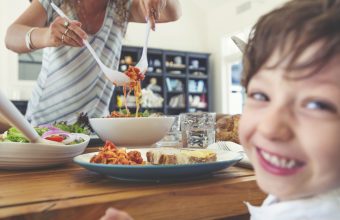Sewing on a button. Ironing a crisp shirt. Creating a nutritious, home-cooked meal. These are just some of the life skills that Gen-Xers have become well-equipped to do thanks to mandatory home economics classes between the 1950s to 70s.
Fast forward to 2017 and children’s exposure to cooking and food preparation activities has decreased in home and school environments, says Health Canada. What’s more is that the average millennial today eats out 235 times a year, according to the 2015 Canadian Chain Restaurant Industry Review.
These realities have the potential to impact our children into adulthood—for better or for worse. For example, adolescents who prepare foods tend to make healthier food choices, characterized by consuming less fat and and more fruits, vegetables, fibre, folate, and vitamin A, according to a Health Canada report. Restaurants and fast-food chains also tend to serve unnecessarily large portions that have excessive levels of sodium, sugar, and fat, often in the form of trans fats. Translation: the more confident your child feels in the kitchen, the less meals they’ll eat out and the healthier they’ll be.
One of the best ways to set your child on a path of healthier eating is to introduce them into the kitchen when they’re young. I know what you’re thinking: what about all the knives, boiling substances, and risks for injury? We’ve come up with a list of safe, child-friendly activities to do with your child in the kitchen.
But first, a reminder: know that involving your kid in the process is going to make it a slower endeavor that will require patience and flexibility. Those little mini cheesecakes you bake together are likely not going to come out perfectly, but that’s hardly the point of baking with your little one. Instead, the point is to teach them life-long skills that will help them be healthier, happier adults.
1. Measuring
Have your child measure out wet and dry ingredients and count out loud together. Then, teach them how to use a spatula to remove every last drop. This is also a good opportunity to introduce them to teaspoons, tablespoons, and measuring cups as well, which will be key tools for any recipe you make together in the future. Want to kick it up a notch? Incorporate quick math exercises into this if it’s age appropriate to do so. For example, ask them what halving the recipe might look like.
2. Mixing
Give your child a spoon, fork, spatula, or whisk to mix together ingredients and watch how they transform in front of their very eyes. If the recipe will allow it, you could also have your child combine ingredients with their hands for a (literally) more “hands on” experience. Experimenting with food colouring in desserts can also be fun during this time to watch how all of the colours transform, and this invites an opportunity to go through primary colours together while allowing your little ones to express their creativity. When your child is ready, you can also teach him or her how to use handheld mixers and other blending tools.
3. Sous-Chef Skills
There are many safe activities your child can engage in to help prepare the ingredients of your dish. For example, they could pick the leaves off of strawberries before you slice them, crack eggs that need to be used, peel bananas or oranges, tear greens, scrub potatoes, portion out cookie dough on a (room temperature) baking sheet, and other such tasks.
4. Know What’s Safe Versus Unsafe
If you’re cooking with raw chicken, outline why frequent hand-washing is so important and model proper washing techniques for your child. Teach them about oven mitts and what can be touched or not based on temperatures, and discuss why cooking with oils and other splatter-inducing ingredients can be dangerous. While this isn’t necessarily a cooking skill your child can master, having this awareness is critical if they’re going to become increasingly responsible and independent in the kitchen. Having that peace of mind will be highly important for you, too.
5. Cleaning Up
Incorporating children into clean-up routines is just as important in getting them involved with the cooking process since it teaches them how to be accountable for messes they create. You can have them sweep the floor, wipe down the counter tops with a non-toxic cleaning spray, and even load the dishwasher.
Welcoming your child into the kitchen at an early age allows them to feel a greater sense of independence and confidence in the kitchen, which can translate into healthier food-related choices in adulthood.
Tagged under: teaching kids responsibilities,healthy lifestyle,kids cooking,healthy eating habits,kids responsibilities
Category: family-life






